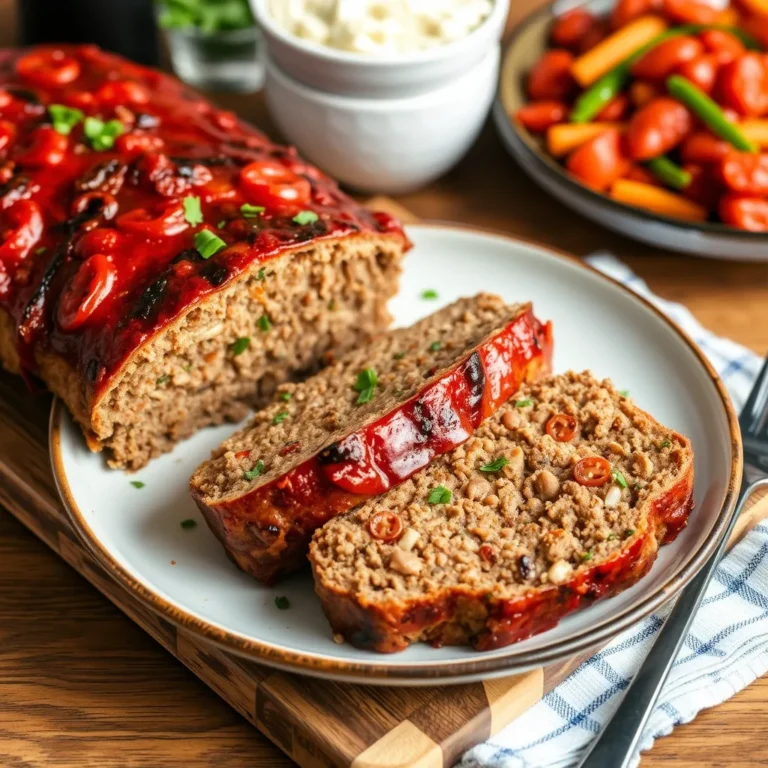Italian meatloaf, or polpettone, is a comforting and flavorful dish rooted in Italian culinary traditions. It combines the heartiness of classic meatloaf with the aromatic richness of Italian herbs and ingredients. In this ultimate guide, we’ll dive into everything you need to know about this beloved dish, from its history and ingredients to its preparation and serving.
What is Italian Meatloaf?
Italian meatloaf elevates the standard meatloaf with traditional Mediterranean flavors. Unlike its American counterpart, it incorporates Italian herbs, cheeses, and a marinara sauce glaze, making it an irresistible centerpiece for any meal. The dish balances savory and aromatic elements, creating a versatile recipe perfect for family dinners or special occasions.
History of Meatloaf in Italian Cuisine
Meatloaf has deep roots in Italy, originating from a desire to use simple, accessible ingredients. During the 19th century, Italian families began incorporating ground meat, bread crumbs, and eggs into their cooking to create a filling and nutritious dish. Over time, regional variations developed, adding local cheeses, cured meats, and specific herbs to reflect distinct culinary traditions.
Italian meatloaf is more than just food—it’s a symbol of creativity and resourcefulness in the kitchen.
Why Italian Meatloaf Stands Out
Italian meatloaf’s standout quality lies in its aromatic depth. By combining ground meats like beef, pork, or veal with Parmesan cheese, basil, oregano, and garlic, the dish achieves a complex, hearty flavor. The addition of marinara sauce and melted mozzarella takes the experience to another level, making every bite unforgettable.
Ingredients That Define Italian Meatloaf
The secret to a perfect Italian meatloaf lies in selecting the right ingredients. Each component plays a crucial role in the dish’s flavor and texture.
Traditional Italian Herbs and Spices
Italian cuisine relies heavily on fresh and dried herbs to enhance its dishes. Key herbs for Italian meatloaf include:
- Basil: Adds a sweet, peppery aroma.
- Oregano: Infuses earthy, robust notes.
- Parsley: Balances flavors with freshness.
- Garlic: Provides a warm, savory base.
Tip: Use fresh herbs whenever possible for the most authentic flavor.
Choosing the Right Type of Meat
A successful Italian meatloaf typically uses a blend of meats, such as:
- Ground beef for a rich, hearty base.
- Ground pork for added fat and flavor.
- Ground veal for a delicate, tender texture.
This combination ensures a balanced and moist loaf that holds together well during cooking.
Essential Add-Ins: Cheese, Breadcrumbs, and Eggs
- Cheese: Parmesan or Pecorino Romano adds a nutty, salty complexity.
- Breadcrumbs: Act as a binder, creating a tender, cohesive loaf.
- Eggs: Provide structure and moisture.
The interplay of these ingredients ensures the meatloaf is flavorful, moist, and firm.
Benefits of Making Italian Meatloaf at Home
Why should you make Italian meatloaf at home? The advantages are plentiful, from cost savings to nutritional benefits.
Cost-Effective Meal Ideas
Homemade Italian meatloaf is an economical way to feed a crowd. Using pantry staples like breadcrumbs, eggs, and canned marinara sauce reduces overall costs while yielding a restaurant-quality dish. Leftovers can be repurposed into sandwiches, wraps, or even pasta fillings.
A Nutritional Take on Italian Meatloaf
When made with lean meats and whole-grain breadcrumbs, Italian meatloaf can be a protein-packed, low-carb meal. Adding fresh herbs and vegetables further boosts its nutritional profile, making it a well-rounded option for health-conscious cooks.
Serving Italian Meatloaf
Once your Italian meatloaf is perfectly cooked, the final step is presentation and pairing. This section focuses on slicing, plating, and pairing your dish with complementary sides for a meal that’s as visually stunning as it is delicious.
How to Slice and Plate Italian Meatloaf
Proper slicing and plating can elevate your Italian meatloaf from homestyle cooking to a gourmet experience.
Garnishing for Visual Appeal
- Add a sprig of fresh basil or parsley for a pop of green.
- Sprinkle freshly grated Parmesan or Pecorino over the top.
- Drizzle extra marinara sauce artfully around the meatloaf slices on the plate.
Ideal Serving Temperatures
- Serve Italian meatloaf warm, ideally at about 140°F (60°C), to retain its flavors and textures.
- If reheating, use the oven at a low temperature or microwave at 50% power to avoid drying it out.
Pairing Italian Meatloaf with Side Dishes
Choosing the right sides can transform your Italian meatloaf into a complete, balanced meal.
Traditional Italian Sides: Polenta, Risotto, etc.
- Creamy polenta: Its smooth texture pairs beautifully with the robust flavors of meatloaf.
- Risotto: Opt for a Parmesan or saffron risotto for a rich, satisfying complement.
- Pasta: A light spaghetti tossed in olive oil and garlic works wonders.
Fresh Salads and Vegetables
For a lighter accompaniment:
- Caprese salad: Tomatoes, fresh mozzarella, and basil provide a refreshing contrast.
- Grilled vegetables: Zucchini, bell peppers, and eggplant add smoky, earthy notes.
- Arugula salad: Toss with lemon vinaigrette for a tangy counterpoint.
Bread Pairings for Italian Meatloaf
- Garlic bread: Perfect for soaking up marinara sauce.
- Focaccia: Its fluffy, herb-infused layers enhance the Italian theme.
- Crusty ciabatta: Complements the meatloaf’s tender texture.
Storing and Reheating Italian Meatloaf
Italian meatloaf is ideal for meal prep and can be stored for future meals without sacrificing quality.
Refrigeration Tips
- Store leftover slices in an airtight container.
- Keep in the refrigerator for up to 4 days.
- Separate slices with parchment paper to prevent sticking.
Freezing for Long-Term Storage
- Wrap the meatloaf tightly in plastic wrap and foil or use a freezer-safe container.
- Freeze for up to 3 months.
- Thaw overnight in the refrigerator before reheating.
Best Practices for Reheating
- Oven: Cover with foil and bake at 350°F (175°C) until heated through.
- Microwave: Reheat in short intervals at medium power, covering with a damp paper towel to retain moisture.
- Stovetop: Warm slices in a skillet with a splash of marinara sauce.
Customizing the Recipe
Personalizing your Italian meatloaf allows you to cater to dietary needs and flavor preferences.
Gluten-Free and Dairy-Free Options
- Replace breadcrumbs with gluten-free panko or almond flour.
- Use dairy-free Parmesan alternatives or nutritional yeast for a cheesy flavor.
Adding a Modern Twist: Unique Ingredient Ideas
- Stuff with spinach and feta: For a Mediterranean-inspired variation.
- Incorporate prosciutto: Adds a savory, salty depth.
- Top with balsamic glaze: For a sweet and tangy finish.
Serving Italian Meatloaf
Once your Italian meatloaf is perfectly cooked, the final step is presentation and pairing. This section focuses on slicing, plating, and pairing your dish with complementary sides for a meal that’s as visually stunning as it is delicious.
How to Slice and Plate Italian Meatloaf
Proper slicing and plating can elevate your Italian meatloaf from homestyle cooking to a gourmet experience.
Garnishing for Visual Appeal
- Add a sprig of fresh basil or parsley for a pop of green.
- Sprinkle freshly grated Parmesan or Pecorino over the top.
- Drizzle extra marinara sauce artfully around the meatloaf slices on the plate.
Ideal Serving Temperatures
- Serve Italian meatloaf warm, ideally at about 140°F (60°C), to retain its flavors and textures.
- If reheating, use the oven at a low temperature or microwave at 50% power to avoid drying it out.
Pairing Italian Meatloaf with Side Dishes
Choosing the right sides can transform your Italian meatloaf into a complete, balanced meal.
Traditional Italian Sides: Polenta, Risotto, etc.
- Creamy polenta: Its smooth texture pairs beautifully with the robust flavors of meatloaf.
- Risotto: Opt for a Parmesan or saffron risotto for a rich, satisfying complement.
- Pasta: A light spaghetti tossed in olive oil and garlic works wonders.
Fresh Salads and Vegetables
For a lighter accompaniment:
- Caprese salad: Tomatoes, fresh mozzarella, and basil provide a refreshing contrast.
- Grilled vegetables: Zucchini, bell peppers, and eggplant add smoky, earthy notes.
- Arugula salad: Toss with lemon vinaigrette for a tangy counterpoint.
Bread Pairings for Italian Meatloaf
- Garlic bread: Perfect for soaking up marinara sauce.
- Focaccia: Its fluffy, herb-infused layers enhance the Italian theme.
- Crusty ciabatta: Complements the meatloaf’s tender texture.
Storing and Reheating Italian Meatloaf
Italian meatloaf is ideal for meal prep and can be stored for future meals without sacrificing quality.
Refrigeration Tips
- Store leftover slices in an airtight container.
- Keep in the refrigerator for up to 4 days.
- Separate slices with parchment paper to prevent sticking.
Freezing for Long-Term Storage
- Wrap the meatloaf tightly in plastic wrap and foil or use a freezer-safe container.
- Freeze for up to 3 months.
- Thaw overnight in the refrigerator before reheating.
Best Practices for Reheating
- Oven: Cover with foil and bake at 350°F (175°C) until heated through.
- Microwave: Reheat in short intervals at medium power, covering with a damp paper towel to retain moisture.
- Stovetop: Warm slices in a skillet with a splash of marinara sauce.
Customizing the Recipe
Personalizing your Italian meatloaf allows you to cater to dietary needs and flavor preferences.
Gluten-Free and Dairy-Free Options
- Replace breadcrumbs with gluten-free panko or almond flour.
- Use dairy-free Parmesan alternatives or nutritional yeast for a cheesy flavor.
Adding a Modern Twist: Unique Ingredient Ideas
- Stuff with spinach and feta: For a Mediterranean-inspired variation.
- Incorporate prosciutto: Adds a savory, salty depth.
- Top with balsamic glaze: For a sweet and tangy finish.
More FAQs: Italian Meatloaf
- What is Italian meatloaf made of?
Italian meatloaf combines ground meats (beef, pork, veal), breadcrumbs, eggs, Parmesan cheese, and Italian herbs, often topped with marinara sauce and mozzarella. - Can I use only beef for Italian meatloaf?
Yes, you can use only ground beef, but a mix of meats (beef, pork, veal) is recommended for richer flavor and better texture. - How do I keep Italian meatloaf moist?
Mixing fatty meats, breadcrumbs, and eggs ensures the meatloaf stays moist. Avoid overcooking and let it rest before slicing. - What can I use instead of breadcrumbs?
Try almond flour, crushed crackers, or rolled oats as substitutes for breadcrumbs. - How long should I bake Italian meatloaf?
Bake at 375°F (190°C) for 45–60 minutes or until the internal temperature reaches 160°F (71°C). - Can I make Italian meatloaf ahead of time?
Yes, assemble the meatloaf a day in advance, refrigerate, and bake it fresh when ready. - What sides go best with Italian meatloaf?
Serve with creamy polenta, risotto, garlic bread, or a fresh arugula salad. - Can Italian meatloaf be frozen?
Absolutely! Wrap it tightly in plastic and foil, and freeze for up to 3 months. Thaw overnight before reheating. - What cheese is best for Italian meatloaf?
Parmesan and mozzarella are classics, but you can also use Pecorino Romano or provolone for a unique twist.

